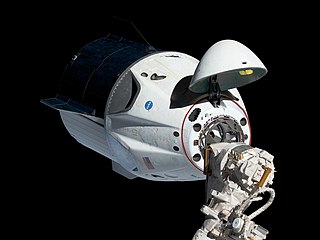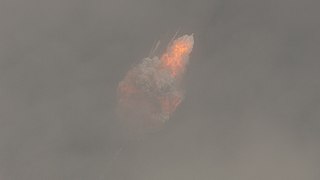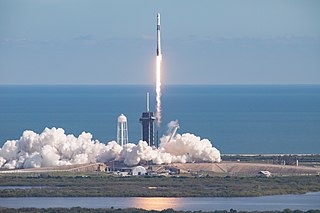 W
WDragon 2 is a class of reusable spacecraft developed and manufactured by American aerospace manufacturer SpaceX as the successor to Dragon 1, a reusable cargo spacecraft. There are two variants: Crew Dragon, a space capsule capable of ferrying up to seven astronauts, and Cargo Dragon, an updated replacement for the original Dragon spacecraft. The spacecraft launches atop a Falcon 9 Block 5 rocket and returns to Earth via an ocean splashdown. Unlike its predecessor, the spacecraft can autonomously dock to the International Space Station (ISS) instead of being berthed.
 W
WAxiom Mission 1 is a planned SpaceX Crew Dragon mission to the International Space Station (ISS), operated by SpaceX on behalf of Axiom Space. The flight will launch in January 2022 and send four people to the ISS for an eight-day stay: Michael López-Alegría a professionally trained astronaut hired by Axiom Space, Eytan Stibbe for Israel, Larry Connor from the United States and Mark Pathy from Canada.
 W
WDragon C208 is the first Cargo Dragon 2 spacecraft, and the first in a line of International Space Station resupply craft which replaced the Dragon capsule, manufactured by SpaceX. The mission is contracted by NASA under the Commercial Resupply Services (CRS) program. It flew for the first time on the CRS-21 mission on 6 December 2020. This was the first flight for SpaceX under NASA's CRS Phase 2 contract awarded in January 2016. This was also the first time a Cargo Dragon was docked at the same time as a Crew Dragon spacecraft. This mission used Booster B1058.4.
 W
WCrew Dragon C204 capsule was part of Crew Dragon flight vehicle SN 2-1 manufactured and operated by SpaceX and used by NASA's Commercial Crew Program. Used in the uncrewed Demo-1 mission, it was launched atop a Falcon 9 rocket on 2 March 2019, arriving at the International Space Station on 3 March 2019. It was the first orbital test flight of the Dragon 2 spacecraft. The spacecraft was unexpectedly destroyed on 20 April 2019 during a separate test when firing the SuperDraco engines at Landing Zone 1.
 W
WCrew Dragon C205 is a Crew Dragon capsule manufactured and built by SpaceX. It completed its first flight on January 19, 2020, with the Crew Dragon In-Flight Abort Test mission where the capsule detached from the Falcon 9 B1046 booster at max Q using the SuperDraco abort thrusters. This was done to test the functionality of the abort thrusters in an operational rocket launch.
 W
WCrew Dragon Demo-1 was the first orbital test of the Dragon 2 spacecraft. This first spaceflight was an uncrewed mission that launched on 2 March 2019 at 07:49:03 UTC, and arrived at the International Space Station on 3 March 2019, a little over 24 hours after the launch. The mission ended following a successful splashdown on 8 March 2019 at 13:45:08 UTC.
 W
WCrew Dragon Demo-2 was the first crewed test flight of the Crew Dragon spacecraft. The spacecraft, named Endeavour, launched on 30 May 2020 at 19:22:45 UTC on top of Falcon 9 Booster B1058.1, and carried NASA astronauts Douglas Hurley and Robert Behnken to the International Space Station in the first crewed orbital spaceflight launched from the United States since the final Space Shuttle mission, STS-135, in 2011, and the first ever operated by a commercial provider. Demo-2 was also the first two-person orbital spaceflight launched from the United States since STS-4 in 1982.
 W
WCrew Dragon Endeavour is a Crew Dragon spacecraft manufactured and operated by SpaceX and used by NASA's Commercial Crew Program. It was launched into orbit atop a Falcon 9 rocket on 30 May 2020 and successfully docked to the International Space Station (ISS) on 31 May 2020 as part of the Crew Dragon Demo-2 mission; this was the first crewed flight test of a Dragon capsule, carrying Doug Hurley and Bob Behnken. It is the spacecraft used in the first crewed orbital spaceflight from the United States since STS-135 in July 2011 and the first crewed orbital spaceflight by a private company. On 2 August 2020 it returned to Earth. The spacecraft was named by Hurley and Behnken after the Space Shuttle Endeavour, aboard which they flew into space during the STS-127 and STS-123 missions, respectively. The name Endeavour is also shared by the command module of Apollo 15.
 W
WCrew Dragon In-Flight Abort Test was a test of the Crew Dragon abort system. The test was conducted on 19 January 2020. It involved the launch of a Falcon 9 from Launch Complex 39A on a suborbital trajectory, followed by an inflight abort of Crew Dragon at max Q. The capsule successfully escaped, while booster B1046 broke up due to aerodynamic forces, as expected.
 W
WThe Crew Dragon Pad Abort Test was a spacecraft test conducted by SpaceX on 6 May 2015 from the Space Launch Complex 40 at Cape Canaveral Air Force Station, Florida. As part of the development of NASA's Commercial Crew Program, the test demonstrated the spacecraft's abort system capability, verifying the capsule's eight side-mounted SuperDraco thrusters' capability to quickly power itself away from a failing rocket while it is still on the ground. It was one of the two tests conducted by SpaceX on the abort system of spacecraft, the other one being the Crew Dragon In-Flight Abort Test conducted on 19 January 2020.
 W
WCrew Dragon Resilience is a Crew Dragon spacecraft manufactured by SpaceX and built under NASA's Commercial Crew Program (CCP). In November 2020, it was launched into orbit to the International Space Station (ISS) as part of the Crew-1 mission. With crew prompting, Resilience docked autonomously to the station at 04:01 UTC on Day 2 of the mission marking the first crewed operational flight of a Crew Dragon craft and the Commercial Crew Program. The mission carried four additional members of Expedition 64 to the three already on station.
 W
WThe Dragon 2 DragonFly was a prototype suborbital rocket-powered test vehicle for a propulsively-landed version of the SpaceX Dragon 2. DragonFly underwent testing in Texas at the McGregor Rocket Test Facility in October 2015. However, the development eventually ceased as the verification burden imposed by NASA was too great to justify it.
 W
WGO Navigator is an offshore supply ship owned and operated by Guice Offshore, and currently deployed as one of the SpaceX Dragon/Dragon 2 recovery vessels along with GO Searcher. Both the vessels are identical and equipped with a medical treatment facility, helipad, lifting frame etc.
 W
WGO Searcher is a SpaceX Dragon recovery vessel. It is one of the offshore supply ships operated by Guice Offshore. The other identical ship is GO Navigator.
 W
WInspiration4 is a spaceflight planned for four people aboard the SpaceX Resilience capsule in late 2021. The three-day flight will be the first human spaceflight to orbit Earth with exclusively private citizens on board. The flight will be privately operated by SpaceX using a previously-flown Crew Dragon capsule launched to low Earth orbit. The flight will be sponsored by Jared Isaacman, who will be on the flight along with Hayley Arceneaux, Christopher Sembroski, and Sian Proctor.
 W
WThe SpaceX Red Dragon was a 2011–2017 concept for using an uncrewed modified SpaceX Dragon 2 for low-cost Mars lander missions to be launched using Falcon Heavy rockets.
 W
WThe Space Adventures Crew Dragon mission is a SpaceX Crew Dragon spaceflight contracted by the American space tourism company Space Adventures scheduled for late 2021 to early 2022.
 W
WSpaceX Crew-1 was the first operational crewed flight of a Crew Dragon spacecraft. It was also the first crewed night launch by the United States since that of STS-131 in April 2010. The Crew Dragon spacecraft Resilience launched on 16 November 2020 at 00:27:17 UTC on a Falcon 9 from the Kennedy Space Center, LC-39A, carrying NASA astronauts Michael Hopkins, Victor Glover and Shannon Walker along with JAXA astronaut Soichi Noguchi, all members of the Expedition 64 crew. The mission was the second overall crewed orbital flight of the Crew Dragon.
 W
WSpaceX Crew-2 is the second crewed operational flight of a Crew Dragon spacecraft, and its third overall crewed orbital flight. The mission was launched on 23 April 2021 at 09:49:02 UTC. The Crew-2 mission transported four members of the crew to the International Space Station (ISS). Crew-2 also used the same capsule as Crew Dragon Demo-2 (Crew Dragon Endeavour) and used the same booster as SpaceX Crew-1 (B1061.2). Endeavour docked with the International Space Station on 24 April 2021 at 09:08 UTC.
 W
WSpaceX Crew-3 will be the third crewed operational flight of a Crew Dragon spacecraft, and the fourth overall crewed orbital flight. The mission is currently planned for launch on 31 October 2021. At a NASA briefing held on 2 May 2021, Steve Stich, program manager of NASA's Commercial Crew Program, said Crew-3 will use a new Crew Dragon that is currently being built. The Crew-3 mission will transport three NASA astronauts and one ESA astronaut to the International Space Station for a six-month long-duration mission.
 W
WSpaceX Crew-4 will be the fourth crewed operational flight of a Crew Dragon spacecraft, and the fifth overall crewed orbital flight. The mission is currently planned for launch in April 2022. Either this flight or Boeing Starliner-1 will launch in April 2022; the other will launch at a later date. The Crew-4 mission will transport four members of the crew to the International Space Station (ISS). As of May 2021, two NASA astronauts and one ESA astronaut have been assigned to the mission, with one more international astronaut to be named later.
 W
WSpaceX CRS-21, also known as SpX-21, was a Commercial Resupply Service mission to the International Space Station which launched on 6 December 2020. The mission was contracted by NASA and was flown by SpaceX using a Cargo Dragon 2. This was the first flight for SpaceX under NASA's CRS Phase 2 contract awarded in January 2016. This was also the first Cargo Dragon of the new Dragon 2 variant, as well as the first Cargo Dragon flight that was docked at the same time as a Crew Dragon spacecraft. This mission used Booster B1058.4, becoming the first NASA mission to reuse a booster previously used on a non-NASA mission. This was also first time SpaceX launched a NASA payload on a booster with more than one previous flight.
 W
WSpaceX CRS-22, also known as SpX-22, is a Commercial Resupply Services (CRS) mission to the International Space Station (ISS) that launched at 17:29:15 UTC on 3 June 2021. The mission is contracted by NASA and is flown by SpaceX using a Cargo Dragon 2. This is the second flight for SpaceX under NASA's CRS Phase 2 contract awarded in January 2016.
 W
WSpaceX CRS-23, also known as SpX-23, is a Commercial Resupply Service mission to the International Space Station with a planned launch date of 18 August 2021. The mission is contracted by NASA and will be flown by SpaceX using the Cargo Dragon C208. This will be the third flight for SpaceX under NASA's CRS Phase 2 contract awarded in January 2016.